
Created: September, 1996
Last updated: 25 December, 2004

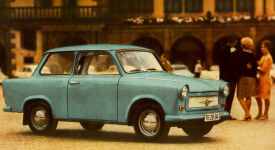

It's been eight years since the Trabant pages were set up. When it was originally published, there was hardly any Trabant-related activity on the Web. By now the landscape changed completely: the Web is part of everyday life and these once forlorn vehicles from Eastern Europe enjoy a nostalgic revival all over the world. You can find home pages for various owners clubs from the UK, Hungary, New Zealand
Trabant-dealers in the USA, tons of pages set up by enthusiasts just like myself, not to mention the presentation of the official factory museum.
So what's the point on keeping this page alive? I don't have any chat forums, Flash movies, enhanced XML-capabilities. But it seems you visitors seem to like the simple layout and can live with my sometimes broken English. So please come on in and enjoy.
From the late '50s a vehicle, a personal carrier emerged from the Eastern part of Germany which became the symbol of Eastern transportation. That's the Trabant.
This car, which originally wasn't destined to be a car, created one of the biggest mistakes in the history of automobiles. In the '50s, when cheap transportation was all the rage throughout Europe and small motorcycles, mopeds were the only means of transport, another idea existed for an intermediate vehicle between the car and the motorbike. Call it bubble-car,
microcar, whatever - You'll get the impression.
The Trabant, and its forerunner, the AWZ P70 were originally intended to be representatives of this intermediate category:
2+2 seater vehicle with a small, easy-to-repair engine, lightweight construction with a little boot at the back. It was to be the perfect means of transportation for the whole family.
By the early 1960s the reasons which brought the Trabant to life, like shortage of steel, fuel, shortage of infrastructure disappeared in Western Europe. The situation also gradually changed in Eastern Europe, but political leaders behind the Iron Curtain reasoned that as it took years for an everyday workers to lay his/her hands on a new automobile (Trabant, Wartburg, Dacia, Lada - you name it) there's precious little need to develop the concept further. Therefore the P60 and then its successor, the P601, better known as the Trabant were kept in production for decades. It was the era of "lack economy" when in the Socialist and Communist countries nothing was taken for granted. To give you an example from the early 1980s: people flocked to stores when news came that bananas or oranges arrived!
So the Trabant which was never planned to be a "normal" automobile evolved to look remotedly like one. But in theory it was still sitting between motorcycles and small cars.
Anyhow, let's look at the history!
DKW - Das Kleine Wunder (The small wonder). The renowned German carmaker's pre-war type F8 equipped with a two-stroke engine became the archetype of all East German family cars.
The Zwickau Automobile Factory (AWZ) continued the production of the F8 and an updated version, the F9 after the War under the authority of the Soviets and then the East Germans.
At the early '50s it became crystal clear that these models were outdated.
In 1953 production of the F9 was transferred to Eisenach, where
EMW and later Wartburg production commenced.
At Zwickau, inside the Automobile Werke Zwickau (AWZ) a new model was developed, called the P70 (P for plastic and 70 for
the displacement which is about 700 cc).
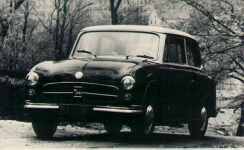 This car was the first German small car made with plastic body. The name of the material was Duroplast made out of resin, strengthened by wool.
This car was the first German small car made with plastic body. The name of the material was Duroplast made out of resin, strengthened by wool.
The AWZ P70 debuted at the 1955 Leipzig Fair. Its engine was based on the old F8: two-cylinder, two-stroke, 690 cc, 22 bhp. With this engine the car which weighed 820 kg had a max. speed of 90 km/h. A three-speed asynchronized gearbox was fitted which transmitted the power to the front wheels.
The mechanical components were plain F8, but the powerplant was rotated by 90 degrees and placed further the front axle. So the wheelbase should've been lengthened by 220 mm. This resulted in better handling.
Beside the "Limousine" body style a "Kombi" estate and even a coupé was offered.
During its four year production life about 30 thousand cars were built.
In the meantime from 1957 on, a new updated model was on the market: the P50.
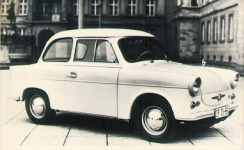

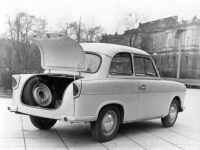
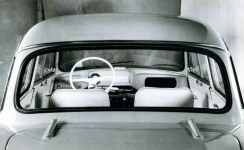
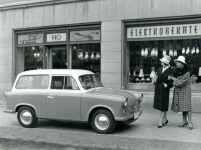
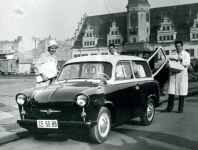
This car carried the "Trabant" badge for the first time - it was selected from various ideas submitted by factory workers.
Comparison of dimensions:
Trabant: 3375 mm length, 1500 mm width and 1395 mm height.
Goggomobil T300 Limousine: 2900 x 1280x 1310 mm.
Yes, the P50 was bigger than the Goggo and more powerful, but the idea was the same. The shape wasn't too bad either, in '50s style.
The P50 as its name suggest carried a smaller engine: 500 cc, 18 bhp, still two-cylinder, two-stroke. The four-speed transmission was still asyncrohinised. Later on came the P60 with a 600 cc engine and slightly modified exterior.
In 1964 after 132000 P50 and P60 models were built AWZ introduced the new P601.

This car had a 594 cc, 26 bhp engine derived from the P50. It sported new cylinders, new cylinder-heads and exhaust system.
The shape is ridiculous now, but it was beautiful for many in the last three decades. It's a normal limousine, not too extravagant.
It was easy to repair, easy to live with. Sure, it soon became outdated, old design but who cared? Here, many family men still cry back to their youth when they had a Trabant. Everyone had a joke about the Trabant, but it was still the basic mean of transport. The epitome of socialism: bad, not capable of doing too many things, not too efficient but still manages
to work somehow :-)
I devoted two pages for the 601:
The first show a couple of illustrations from various brochures with the technical details, the second is more artful with pictures of 601s in Hungary. This page explains a few
things which You have to know to understand the Trabant-legend.
Copyright © September, 1996-2004.
Pal Negyesi npaul@hu.inter.netDisclaimer: KTUD Archive was created to feature automotive history. Read it, enjoy it but as many hours of work went into the creation I don't want any impostors to do something with the information or pictures without asking me, the maintainer. Thanks.